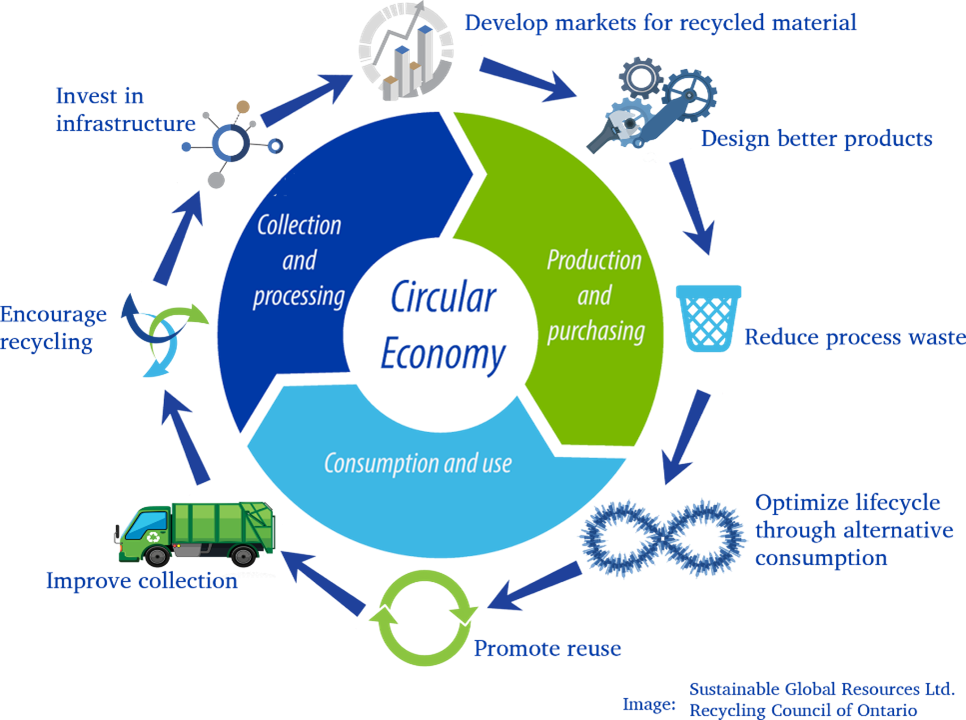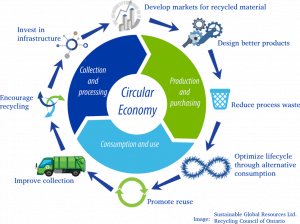Solar and the Circular Economy

At Terawatt Solar, we take careful steps to ensure the utmost responsibility to minimize our carbon emissions. We believe that transitioning to renewable energy is a quintessential step that we can take to ensure locally sourced green and clean technology – for now and countless generations to come. It is essential that we collectively and individually begin to take steps towards Canada staying aligned with the Paris Agreement, and also take steps towards promoting a “circular economy”. Terawatt Solar ensures that we are transparent and honest with our economical practices, and that together, we can take a path towards sustainable ecological economical development.
What is a Circular Economy? Why should we switch?
One message is clear – the global population is rising, and it is essential that Canada begins to transition towards sustainability. The planet itself has finite resources. The resources are limited, and extraction processes for resources, oftentimes, are not rooted in ethics. Furthermore, extraction levels increase carbon emissions everywhere, and consequently, impact the environment as a result. A circular economy helps to promote repurposing, recycling, and efficient usage in order to lower global GHG emissions to ensure that we stay aligned with the IPCC report and the Paris Agreement. We must work towards the integral sustainable development of our communities, natural ecosystems, and public health. A circular economy is defined as “a model of production and consumption, which involves sharing, leasing, reusing, repairing, refurbishing and recycling existing materials and products as long as possible that aims at tackling global challenges like climate change, biodiversity loss, waste, and pollution”.

What are the Principles of a Circular Economy?
A circular economy promotes recycling waste as resources and inputs these resources into already pre-existing and finished goods. The good news is that materials which are biological and biodegradable do not need repurposing, and can instead, biodegrade into nature. Other materials can be re-introduced and repurposed in production in order for them to be utilized for newer products. Repurposed materials can also be utilized towards repairing damaged products. Additionally, is certain materials cannot be repurposed or recycled, they will be used towards energy for the entire community. As a result, all materials are repurposed and remain sustainable and ecologically friendly.

How Does a Circular Economy Benefit Solar?
According to Taylor Curtis, a Sustainability Analyst at National Renewable Energy Laboratory, “Responsible and cost-effective management of PV system hardware is an important business and environmental consideration. Repair, reuse, or recovery of this equipment would reduce negative environmental impacts, reduce resource constraints, and stimulate U.S. economic growth.” A circular economy ensure economies are rooted in purposeful profit. The first step lies in ensuring literature-based research is conducted with solar industries, policy makers and regulators. At this point in time, governments provide little incentives for private industries and companies to invest in the recycling of its materials – including repair, reuse and repurposing. A circular economy would motivate the market and economy towards sustainable stability within its supply chains, would improve scarcity in relation to resources, reduce manufacturing costs, offer innovative revenue streams for businesses, provide tax benefits, new jobs, and would ultimately improve any company’s brand and reputation with its alignment towards sustainable and environmental interests. With sustainability and a circular economy in mind, photovoltaic systems could be repaired, recycled and reused. However, to ensure that sustainability is furthered, first steps must begin with fundamental changes within commercial, industrial and residential infrastructure. The consumer must be valued and must benefit from increased access to renewable energy sectors, as well as efforts towards climate change solutions. One great example of this is the “Circular Economy Action Plan”, which ensures that batteries can be “recovered as valuable materials”. The term “waste” is re-evaluated by the European Commission to lead towards quintessential changes that promote regulations and sustainability.

Concluding Thoughts
Sustainability, solar energy and a circular economy have countless benefits in interdisciplinary relationship with one another, as well as on our country. The possibilities are endless, especially for sustainable development. A circular economy advocates for the reuse and refurbishing of resources.
A circular economy lies at the root of our transition towards renewable energy alternatives. Two crucial principles are the elimination of waste/pollution, and ensuring materials stay in use. A goal and target towards both renewable energy and a circular economy would motivate the private sector, policy makers, industries and regulators towards Canada’s intended goal for net-zero and would allow for us to meet the necessary targets in a more timely manner. Together, we can ensure economic development and ecological integrity lie at the heart of what we do.
Consider connecting with Terawatt Solar to assist you with Canada’s renewable and clean energy process. Our licensed consultants and installers can ease you through your transition to solar to ensure that you optimize your home ecologically, affordably and with great ease. We are here to help you with your energy and solar needs.
Consider our free solar assessment today, and book an appointment to learn more: